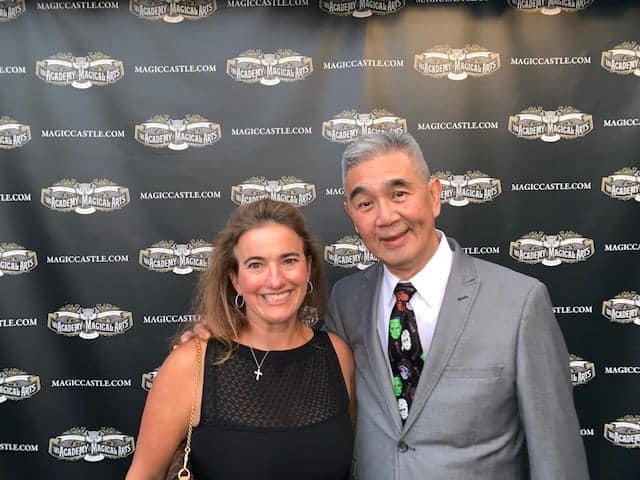See the full story with video at the UAMS News site.
Claudia Bressie’s tumor was non-cancerous, but it was aggressive and dangerous. Months of consultations at top universities and treatments proved ineffective for the San Francisco woman, until her journey brought her to UAMS.

It began in 2017 when Bressie started having swelling, popping and clicking around her jaw. The discomfort grew from there to what felt like stabbing pain accompanied by dizziness and vertigo.
Suen demonstrates how he and Day surgically removed Bressie’s tumor.
Because tenosynovial giant cell tumors have a high rate of recurrence, Bressie and her physicians were concerned about the possibility of operating in that very delicate area multiple times. What’s more, her surgical options had a high risk of her losing the ability to use her jaw and facial muscles and her hearing.
Bressie’s pharmaceutical sales experience gave her the helpful background knowledge to be an effective advocate for herself. She began learning all she could about her condition and treatment options.
“I went to multiple hospitals including UCSF, Stanford and MD Anderson. I felt pretty despondent with the different surgical methods the doctors were – recommending for me,” Bressie said. “My sister, a dentist who lives in Maryland, has a friend in Little Rock who serves as a board member at our Winthrop P. Rockefeller Cancer Institute with Dr. Suen. He mentioned my case to Dr. Suen and out of the kindness of his heart he said, ‘Have her send me images and I’ll look over them.’ That’s how it began.
James Suen, M.D., a distinguished professor in the Department of Otolaryngology in the UAMS College of Medicine, is a world-renowned surgeon who specializes in a variety of complex otolaryngology cases.
Synovial giant cell tumors are very rare in the jaw joint and Suen had never seen one in 50 years of practice, although he has treated thousands of tumors in this area. Although these tumors are considered benign, they are very aggressive and difficult to cure. Her tumor had eroded through the bone over her jaw joint into the skull next to her brain. After meeting with Suen, Bressie was confident in his approach to removing the tumor, which Suen said he felt he could do without disfiguring her face or compromising her ability to eat and talk normally.
J.D. Day, M.D., UAMS professor and chief of neurosurgery
It would be an – interdisciplinary approach. Suen asked J.D. Day, M.D., UAMS professor and chief of neurosurgery, to be involved with the case. While Suen would concentrate on the jaw and face, Day, who is an internationally known leader in skull base surgery, would focus on the sections nearest the brain. Together, the two surgeons consulted with Bressie, studied her images closely, and felt they could remove the tumor, get clean margins, and hopefully prevent recurrence.
“My sister came with me to my visit. Dr. Suen and Dr. Day seemed confident. And we felt good about their approach. I said, ‘We can stop here. Dr. Suen and Dr. Day are the ones!’”
“The tumor is not classified as a cancer, but it is very aggressive and acts like a cancer,” Suen said. “When we studied her scans, we saw the tumor had destroyed the jaw joint bone and was inside her skull and sitting next to her brain.”
In the surgery, Suen took away small bits of the tumor at a time checking for margins to avoid radical resection. You can’t take away too much at one time, he said, because the patient would end up with major complications.
The surgeons approached the tumor by opening and peeling back the right side of her face and scalp. Day removed the tumor inside the skull. Suen removed the tumor in and around the jaw joint. Once they got rid of all of it, they reconstructed her face.
You can hardly see any scar. “She looks amazing,” Suen said. “It turned out well. I’m pleased with that.”
“The way Dr. Suen and Dr. Day did my surgery was the best for me as far as an outcome for not having long-term issues. There’s a lot that can go wrong if you don’t know what you’re doing.”
Bressie noticed immediately after surgery that seemingly unrelated pain in her left knee was gone.
“That was just more confirmation of how aggressive the tumor was, already starting to affect her brain,” Suen said.
Bressie comes from an active family and is grateful this hasn’t slowed her down too much. The married mother of three enjoys tennis, downhill skiing, running and paddle boarding. She was cleared to run again after her visit with Suen in June.
“I was a little cautious to go all in because I didn’t want any setbacks.
She received good news from her most recent visit. There was no evidence of recurrence of the tumor. Suen called that an excellent sign.
“If she goes out two years without a recurrence, there is a good chance she is cured,” he said.
“I understand and sympathize with our doctors who are under a tremendous amount of pressure, with an ever increasing patient load,” Bressie said. “Dr. Suen carries the same challenges with grace and dignity. He slows down to take the time to treat each patient as if they’re family. He is a master at what he does by addressing your disease with precision, clarity and confidence. Dr. Suen is both empathetic and calming towards the patient’s fear and uncertainty. I’m blessed to have found him!”
Two years and several hospitals and doctors later, Bressie had a diagnosis from physicians at the University of California, San Francisco (UCSF): tenosynovial giant cell tumor. It is rare. And in most occurrences, the tumors appear in the knee joint and sometimes the hip. (A synovium is the covering of any joint found between bones like the elbows, shoulders, knees or hips.) Bressie’s tumor was in her TMJ joint, on the right side and very close to her brain.
